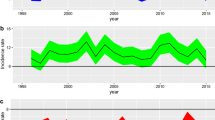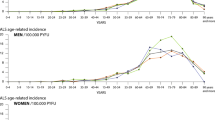Abstract
Amyotrophic Lateral Sclerosis (ALS) is a progressive neurodegenerative disease with an unknown cause. Studies have reported that the incidence rate of ALS might be changing. As ALS is an age related disease, crude incidence could increase as population structure changes and overall life expectancy improves. Age-period-cohort (APC) models are frequently used to investigate trends in demographic rates such as incidence. Age-specific incidence rate for ALS from 1996 to 2014 were taken from a population-based ALS register in Ireland. To circumvent the well-known identifiability issue in APC models, we apply the method of Partial Least Squares Regression to separate the effects of Age, Period and Cohort on ALS incidence over time. This APC analysis shows no cohort effect and the initial signs of a period effect; increasing incidence of ALS in the most recently diagnosed group. As further years of data accrue to the Irish register it will become clear if this effect emerges as a strong trend in the incidence of ALS in Ireland and replication of these analyses in other populations will show if our findings on temporal patterns in ALS incidence are shared elsewhere.



Similar content being viewed by others
References
Logroscino G, Traynor BJ, Hardiman O et al (2010) Incidence of amyotrophic lateral sclerosis in Europe. J Neurol Neurosurg Psychiatry 81(4):385–390
O’Toole O, Traynor BJ, Brennan P et al (2008) Epidemiology and clinical features of amyotrophic lateral sclerosis in Ireland between 1995 and 2004. J Neurol Neurosurg Psychiatry 79:30–32
Murphy M, Quinn S, Young J, Parkin P, Taylor B (2008) Increasing incidence of ALS in Canterbury, New Zealand: a 22-year study. Neurology 71(23):1889–1895
Georgoulopoulou E, Vinceti M, Bonvicini F et al (2011) Changing incidence and subtypes of ALS in Modena, Italy: a 10-years prospective study. Amyotroph Lateral Scler 12(6):451–457
Chiò A, Cucatto A, Calvo A, Terreni AA, Magnani C, Schiffer D (1999) Amyotrophic lateral sclerosis among the migrant population to Piemonte, northwestern Italy. J Neurol 246(3):175–180
Chiò A, Logroscino G, Traynor BJ et al (2013) Global epidemiology of amyotrophic lateral sclerosis: a systematic review of the published literature. Neuroepidemiology 41(2):118–130
European Commission. Eurostat–Statistics Explained. Population Structure and Ageing (Internet). 2015 (cited 2015 Nov 20). http://ec.europa.eu/eurostat/statistics-explained/index.php/Population_structure_and_ageing
Ford ES, Roger VL, Dunlay SM, Go AS, Rosamond WD (2014) Challenges of ascertaining national trends in the incidence of coronary heart disease in the United States. J Am Heart Assoc 3(6):e001097
Bennett K, Hughes J, Jennings S, Kee F, Shelley E (2013) Comparing the decline in coronary heart disease and stroke mortality in neighbouring countries with different healthcare systems. Heart 99(16):1179–1184
Ajdacic-Gross V, Schmid M, Tschopp A, Gutzwiller F (2012) Birth cohort effects in neurological diseases: amyotrophic lateral sclerosis, Parkinson’s disease and multiple sclerosis. Neuroepidemiology 38:56–63
Gordon PH, Artaud F, Aouba A, Laurent F, Meininger V, Elbaz A (2011) Changing mortality for motor neuron disease in France (1968–2007): an age-period-cohort analysis. Eur J Epidemiol 26(9):729–737
Seals RM, Hansen J, Gredal O, Weisskopf MG (2013) Age-period-cohort analysis of trends in amyotrophic lateral sclerosis in Denmark, 1970–2009. Am J Epidemiol 178(8):1265–1271
Carstensen B (2007) Age-period-cohort models for the Lexis diagram. Stat Med 26(15):3018–3045
McNally RJ, Alexander FE, Staines A, Cartwright RA (1997) A comparison of three methods of analysis for age-period-cohort models with application to incidence data on non-Hodgkin’s lymphoma. Int J Epidemiol 26(1):32–46
Tu YK, Davey Smith G, Gilthorpe MS (2011) A new approach to age-period-cohort analysis using partial least squares regression: the trend in blood pressure in the Glasgow Alumni cohort. PLoS One 6(4):e19401
Jiang T, Gilthorpe MS, Shiely F et al (2013) Age-period-cohort analysis for trends in body mass index in Ireland. BMC Public Health 13(1):889
Tu YK, Keyes K, Davey Smith G (2014) Mortality cohort effects from mid 19th to mid 20th century Britain: did they exist. Ann Epidemiol 24(8):570–574
Rooney J, Vajda A, Heverin M et al (2015) Spatial cluster analysis of population amyotrophic lateral sclerosis risk in Ireland. Neurology 84(15):1537–1544
Central Statistics Office. CSO Statistical Databases (Internet). Unknown (cited 2015 May 15). http://www.cso.ie/en/databases/
Tu YK, Kramer N, Lee WC (2012) Addressing the identification problem in age-period-cohort analysis. A tutorial on the use of partial least squares and principal components analysis. Epidemiology 23:583–593
R Core Team (2014) R: a language and environment for statistical computing. R Foundation for Statistical Computing, Vienna. http://www.R-project.org/
Mevik BH, Wehrens R (2007) The pls package: principal component and partial least squares regression in R. J Stat Softw 18:1–24
Haenlein M, Kaplan AM (2004) A beginner’s guide to partial least squares analysis. Underst Stat 3(4):283–297
Acknowledgments
This work was funded by a Health Research Board Interdisciplinary Capacity Enhancement Award, Grant Number ICE/2012/6.
Author information
Authors and Affiliations
Corresponding author
Ethics declarations
Ethical approval
Ethical approval for this study was granted by Beaumont Hospital Ethics (Medical Research) Committee.
Conflicts of interest
Both Dr. Katy Tobin and Dr. James Rooney were funded under separate Grants from the Health Research Board during the conduct of the study. Prof. Orla Hardiman has received speaking honoraria from Janssen Cilag, Biogen Idec, Sanofi Aventis, Novartis and Merck-Serono. She has been a member of advisory panels for Biogen Idec, Allergen, Ono Pharmaceuticals, Novartis, Cytokinetics and Sanofi Aventis. She serves as Editor-in-Chief of Amyotrophic Lateral Sclerosis and Frontotemporal Dementia. Funding is from Health Seventh Framework Programme (FP7/2007-2013) under Grant Agreement No. 259867, ALSA (the ALS Association), HRB (the Health Research Board, Grant H01300), Joint Programme in Neurodegeneration (JPND), and Research Motor Neuron (previously named Motor Neuron Disease Research Foundation). All other authors have no conflicts of interest to declare.
Electronic supplementary material
Below is the link to the electronic supplementary material.
Rights and permissions
About this article
Cite this article
Tobin, K., Gilthorpe, M.S., Rooney, J. et al. Age-period-cohort analysis of trends in amyotrophic lateral sclerosis incidence. J Neurol 263, 1919–1926 (2016). https://doi.org/10.1007/s00415-016-8215-z
Received:
Revised:
Accepted:
Published:
Issue Date:
DOI: https://doi.org/10.1007/s00415-016-8215-z




